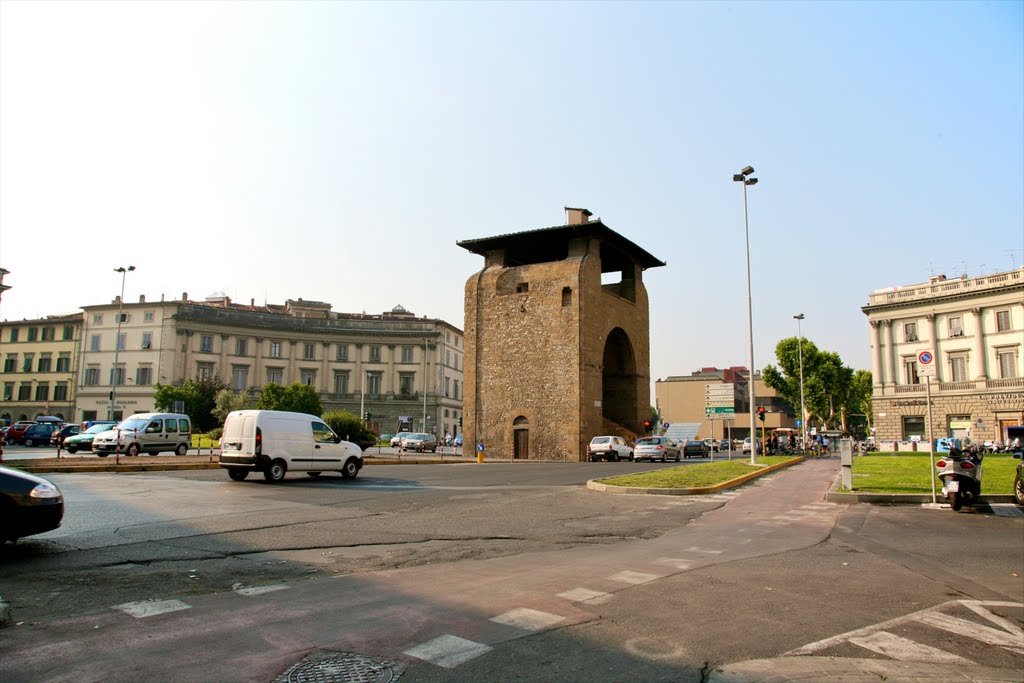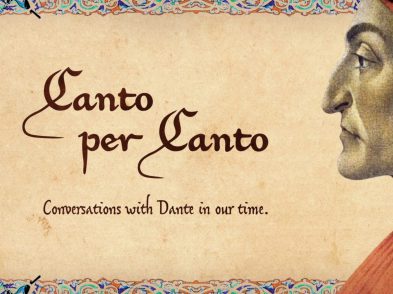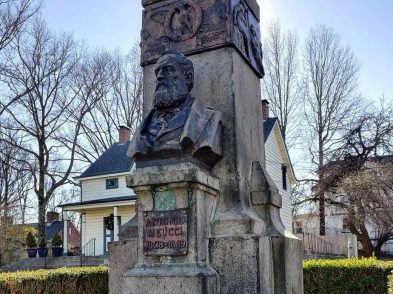It was a midday Italian scorcher in piazza Beccaria and I was sitting on a bench which was leaving griddle marks on my backside. I had fought a passive aggressive war for those six inches of stone bench, and I wasn’t about to give them up. On those scorching summer days when Florence rather marvelously—and unapologetically—misbehaves, Cesar Beccaria serves as an apropos namesake for this non-square.
Piazza Beccaria is less a true piazza and more a circular gateway to Florence’s historic center. Its lunettes are traversed by a broad, traffic-congested viale where the lanes are mere suggestions. While the late 13th century walls were stripped long ago, the tired, weather-beaten arch of Porta alla Croce is still impressive. It appears to stand in time immemorial as a reminder of historical intersections.
Cesare Beccaria was a jurist who represented the apex of 18th century Italian Enlightenment philosophy. He famously wrote the treatise On Crimes and Punishments, focused on the need for an overhaul of the antiquated justice system. He spoke out against the death penalty and advocated against torture. Widely read, in many languages, he was quoted by the likes of Thomas Jefferson and Catherine the Great. But Beccaria is an odd namesake for a piazza just beyond which public executions were once performed. And the irony of his plea against torture ran even deeper on one particular summer day.
While Beccaria had written brilliantly against torture, it appeared that ATAF buses had not gotten the message about the social contract that all of us waiting around at the stop had signed. Each time the electronic bus sign flashed a warning that it was a code red heat emergency and that we should not be sitting in the sun waiting for the bus, the herd of wilted Italians groaned in a chorus of misery.
Since the first scheduled bus that hour never showed up, and magically disappeared from the sign with no explanation, they had formed a semi-circle curbside, determined to get to the bottom of things. As the crowd grew, it became obvious that that even if the little electric “C” bus were to arrive, it would never fit this many desperate passengers. This was about to become Lord of the Flies.
The misery reached a crescendo and arms started flying when the “you are going to end up in the hospital if you exert yourself” message scrolling on the bus stop sign was replaced by the most infamous of Italian words. Blazing there in digital red pixels, in all caps I saw it: SCIOPERO.
“No!” the crowd moaned. First Pitti Uomo tangled traffic and made getting a cab next to impossible, the tramvia was on the fritz, and now a strike. I contributed a few hand gestures in solidarity to make sure that our response to this torture reached the high heavens.
My curbside crowd, positioned to pounce on a bus should one show up, suddenly heard a cry from the shade, where the less optimistic souls were waiting. Apparently a rug had fallen from a clothes line a few floors above the masses. The crowd undulated toward this new development to be assessed. Their shouting rose up to the open window, where I could see a small plume of cigarette smoke escaping from just inside the frame. The message from the street ranged from “Hey, you lost your rug!”, to the more accusatory “What the hell were you thinking? Are you trying to kill someone?”. Within seconds a small overheated poodle had parked himself on top of the rug and voiced his general irritation. Whoever was smoking never made an appearance, surely because this crowd would take no prisoners. Only Beccaria himself could have talked them out of rash action.
The rug had just been abandoned when it became clear that a bus was finally arriving. But as it puttered into the Piazza, the dreaded Fuori Servizio light was turned on. Out of service. The desperate crowd, in disbelief, tried to board anyway. Perhaps they thought the driver would change his mind? Even when he cut the engine and stood there sheepishly smoking, they remained on the bus, in denial. Eventually the bus turned into an oven, and the desperate souls poured back into the piazza.
I don’t know if a (fully operational) bus ever came. I don’t know if the owner of that rug ever dared to appear. They could still be waiting. At this point I was on fire and my 90 minute ticket had expired. In the spirit of Beccaria, who spoke widely of free will, I decided to exercise mine. I gave up my six inches of bench, tossed my ticket into an overflowing trash can and began the long walk home, musing about how Beccaria would in no way approve of this abject torture. His utilitarianism was due for a comeback, I decided. Maybe come winter.









